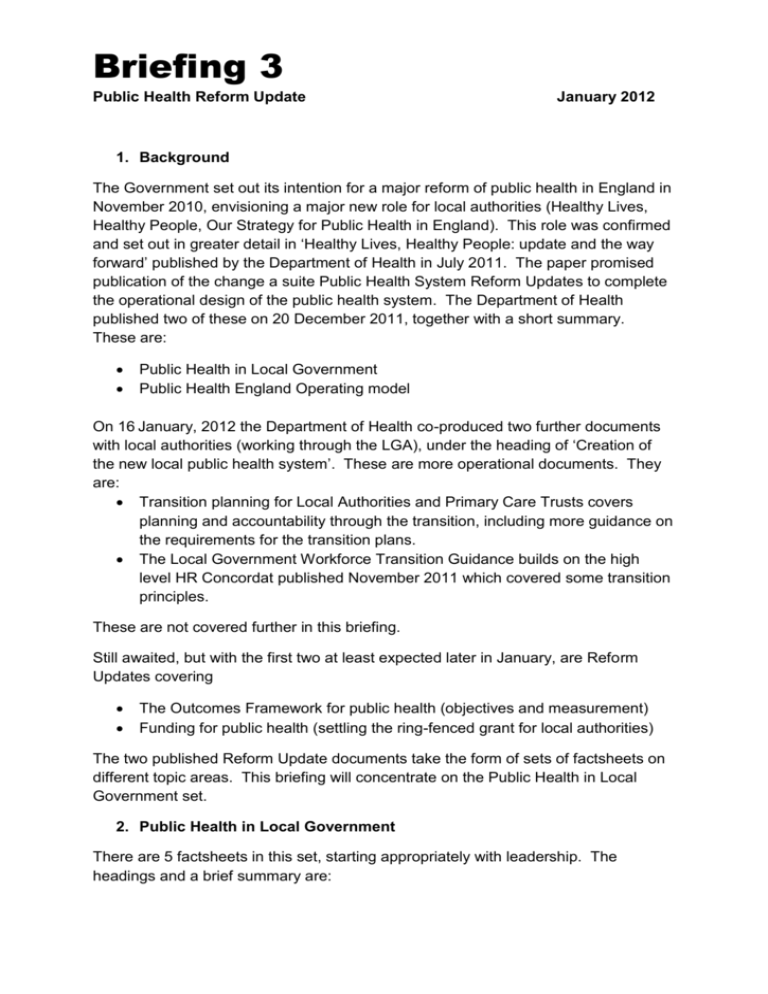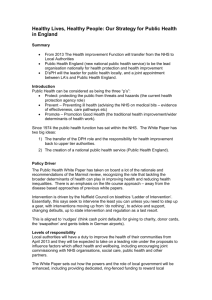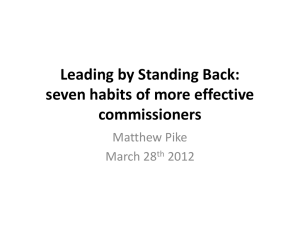Public Health Reform Update Briefing
advertisement

Briefing 3 Public Health Reform Update January 2012 1. Background The Government set out its intention for a major reform of public health in England in November 2010, envisioning a major new role for local authorities (Healthy Lives, Healthy People, Our Strategy for Public Health in England). This role was confirmed and set out in greater detail in ‘Healthy Lives, Healthy People: update and the way forward’ published by the Department of Health in July 2011. The paper promised publication of the change a suite Public Health System Reform Updates to complete the operational design of the public health system. The Department of Health published two of these on 20 December 2011, together with a short summary. These are: Public Health in Local Government Public Health England Operating model On 16 January, 2012 the Department of Health co-produced two further documents with local authorities (working through the LGA), under the heading of ‘Creation of the new local public health system’. These are more operational documents. They are: Transition planning for Local Authorities and Primary Care Trusts covers planning and accountability through the transition, including more guidance on the requirements for the transition plans. The Local Government Workforce Transition Guidance builds on the high level HR Concordat published November 2011 which covered some transition principles. These are not covered further in this briefing. Still awaited, but with the first two at least expected later in January, are Reform Updates covering The Outcomes Framework for public health (objectives and measurement) Funding for public health (settling the ring-fenced grant for local authorities) The two published Reform Update documents take the form of sets of factsheets on different topic areas. This briefing will concentrate on the Public Health in Local Government set. 2. Public Health in Local Government There are 5 factsheets in this set, starting appropriately with leadership. The headings and a brief summary are: Briefing 3 Local Government leading for public health The role of local government as a place shaper is stressed, as is local authorities’ democratic mandate, local knowledge and understanding, expertise in building relationships with its population and strategic partners. The vision is for local authorities to bring a health and well-being focus (its new statutory duty) to bear across all its current business, focusing particularly on reducing health inequalities. The Directors of Public Health will be well placed to help local authorities reduce and prevent inequalities, taking a strategic approach, working with partners in the council, the NHS and more broadly partners such as the incoming Police and Crime Commissioners to look at preventing violence and offending. Public health work in local authorities will require: - Including health in all policies Investing the new ring-fenced grant in high quality public health services Encouraging health promoting environments Supporting local communities Tailoring services to individual need, taking a holistic approach Making effective and sustainable use of all resources, using evidence to direct support to areas and groups of greatest need. Local Government’s new public health functions Subject to legislation, upper tier and unitary authorities will have a new duty to promote the health of their local population. It emphasises the importance of political leadership of public health within the council, with broad engagement and understanding of all members as well as the critical role of the cabinet lead for health. The factsheet makes some general comments on commissioning, covered in greater detail in another of this set of factsheets, including the expectation that authorities will wish to commission rather than provide services and an encouragement to use a wide variety of providers. The legislation will enable the Secretary of Health to require that certain services are provided (mandated) which will be used only where uniformity of provision is regarded as essential. The role of the Director of Public Health The Health and Social Care bill makes it clear that each local authority must have a Director of Public Health appointed jointly with the State for Health (through Public Health England). The Directors must be approved specialists and, subject to amending the Local Government and Housing Act 1989) will have Chief Officer status within the Council. Further guidance on their appointment is being developed. The Government expects direct accountability to the local authority Chief Executive for the exercise of the local authority’s public health responsibilities. The responsibilities will be Briefing 3 - All public health functions of local authorities Annual report on the health of the local population Statutory membership of health and well-being boards Promoting opportunities for action across the ‘life course’ working with Directors of Children’s Services and Adult Services Working with local criminal justice partners and proposed new Police and Crime commissioners Day to day responsibility for the ring fenced grant The Directors of Public Health should be involved in the design of the new arrangements and with all local authority colleagues to ensure an understanding of the new role and with the new NHS commissioners. Further advice on Workforce to ensure an appropriate supply of specialists and other public health staff will be published, with consultation on the issue promised. Commissioning Responsibilities A very detailed factsheet, this one lists the services for which local authorities will be responsible. ( See Appendix 1 attached). There is only one significant change from earlier lists; the exclusion of termination of pregnancy services from the sexual health responsibilities. They will remain provisionally with the NHS and will be commissioned by Clinical Commissioning Groups (CCGs). Sexual Assault Referral Centres (SARCs) will initially be commissioned by the NHS Commissioning Board. The decisions on commissioning public health services for children, with local authorities responsible initially for services for children and young people 5-19 is reiterated along with the expectation of transfer of the responsibilities for 0-5s from the NHS Commissioning Board in the medium term (2015). More detail is given on the responsibilities for which the local authorities will be working with other bodies, in particular health protection plans for the local population, covering immunisation and screening and emergency and resilience planning. The public health role role in health protection planning will be a key leadership one. Further guidance on emergency planning is promised. The provision Public health advice to commissioners is a key role of the new local authority responsibilities. It is referenced in this fact sheet and covered in greater depth in a separate one (see below). Public Health advice to NHS Commissioners This factsheet details the public health advice that local authorities will be expected to give to NHS commissioners, in the form of a table which details each aspect of provision with examples alongside. It is arranged under 5 headings: Strategic planning: reviewing service provision Strategic planning: deciding priorities Briefing 3 Procuring services: deciding the shape and structure of supply Procuring services; planning capacity and managing demand Monitoring and evaluation, supporting choice, managing performance and seeking public and patient views Professional appraisal and support and capacity building This factsheet flags the point that Public health specialists (both medical and nonmedical professionals working in local authorities will need to undergo revalidation/professional appraisal. Local authority chief executives will be responsible for managerial appraisal. 3. Public Health England Operating Model This document comprises 5 factsheets, headings and key points are: Mission and values The mission is given as to protect and improve the wellbeing of the population and to reduce inequalities in health and wellbeing outcomes. Great emphasis is placed on working across the new public health system with key partners including local authorities. Functions The three functions listed are: - Delivering services to national and local government, the NHS and the public Leading for Public Health Supporting the development of the specialist and wider public health network Organisational design Importantly, this covers the geography of the new organisation. There will be a central national office and four geographical hubs, likely to match those of the NHS Commissioning Board. One of these will cover North of England. Below this will be 25 hubs, based on existing Health Protection Agency (HPA) operating units. The HPA has a hub covering the North East. Further work will be done on the design and role of the units. They will have a major role in health protection and emergency preparedness and provision of some local intelligence. Status and accountability HPE will be an executive agency of the Department of Health. Next steps – establishing Public Health England This contains a timetable with key milestones, completing in April 2013 (subject to legislation). Briefing 3 Conclusions These documents are very helpful to the transition planning. They introduce no major changes to previous announcements and imply no particular changes to the public health transition planning in hand at local, north east regional, SHA cluster and national levels. The next milestone being the development of transition plans at local levels (local authority/Primary Care Trust) levels by the end of January 2012 for finalisation by the end of March. The publication of the outstanding documents (outcomes and funding) is important, as some key decisions on staffing and services depend on decisions expected in them. Elaine Rodger Senior Manager, Public Health Elaine.rodger@northumberland.gov.uk 01670 533901 17 January 2012 Briefing 3 Appendix 1 Proposed Local Authority Public Health Responsibilities The mandatory services include: Appropriate access to sexual health services (except abortion services, which will be commissioned by CCGs, and Sexual Assault Referral Centres (SARC), which will be commissioned by NHSCB)) Duty to ensure there are plans in place to protect the health of the population Ensure NHS commissioners receive public health advice they need Deliver the National Child Measurement Programme Deliver the NHS Health Check Programme (The elements of the Healthy Child Programme (age 5-19) previously proposed as mandated is subject to further review and will not be mandated during 2013). Other commissioning responsibilities include: Prevention and Lifestyle services Tobacco control and smoking cessation services Alcohol and drug misuse services Public health services for children and young people aged 5-19 Interventions to tackle obesity such as community lifestyle and weight management services Locally-led nutrition initiatives Increasing levels of physical activity in the local population Public mental health services Dental public health services Accidental injury prevention Population level interventions to reduce and prevent birth defects Behavioural and lifestyle campaigns to prevent cancer and long term conditions Local initiatives on workplace health Health Protection Supporting, reviewing and challenging delivery of key public health funded and NHS delivered services such as immunisation and screening programmes Local initiatives to reduce excess deaths as a result of seasonal mortality Local authority role in dealing with health protection incidents, outbreaks and emergencies Local initiatives that reduce public health impacts of environmental risks Wider determinants of health Public health aspects of promotion of community safety, violence prevention and response Public health aspects of local initiatives to tackle social exclusion







